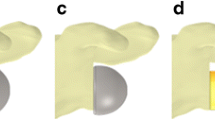Abstract
Purpose
The purpose of this study is to demonstrate that inferior inclination of the glenosphere is a protecting factor from joint dislocation in reverse total shoulder replacement. The hypothesis is that an average of 10° of inferior inclination of the glenoid component would determine a significant inferior rate of dislocation as compared to neutral inclination.
Methods
A retrospective case (dislocation)–control (stability of the implant) study was performed. Inclusion criteria were the homogeneity of the prosthetic model and availability of pre- and postoperative imaging of the shoulder, including antero-posterior and axillary X-ray views. Glenoid and glenosphere inclination were calculated according to standardized methods. Difference in between the angles determined the inferior tilt.
Results
Thirty-three cases fit the inclusion criteria. Glenoid and glenosphere inclination measured, respectively, 74.1° and 83.5°. The average tilt of the glenosphere measured 9.4°. The average tilt in stable patients was 10.2°. Tilt in patients with atraumatic dislocation measured, respectively, −6.9° (superior tilt) and 2.4°, while it was 8.3° for the patient with traumatic instability. The association between the tilt of glenosphere and atraumatic dislocation was significant.
Conclusions
A 10° inferior tilt of the glenoid component in reverse shoulder arthroplasty is associated with a reduced risk of dislocation when compared to neutral tilt.


Similar content being viewed by others
References
Affonso J, Nicholson GP, Frankle MA, Walch G, Gerber C, Garzon-Muvdi J, McFarland EG (2012) Complications of the reverse prosthesis: prevention and treatment. Instr Course Lect 61:157–168
Clark JC, Ritchie J, Song FS, Kissenberth MJ, Tolan SJ, Hart ND, Hawkins RJ (2012) Complication rates, dislocation, pain, and postoperative range of motion after reverse shoulder arthroplasty in patients with and without repair of the subscapularis. J Shoulder Elbow Surg 21(1):36–41
Farshad M, Gerber C (2010) Reverse total shoulder arthroplasty-from the most to the least common complication. Int Orthop 34(8):1075–1082
Trappey GJt, O’Connor DP, Edwards TB (2011) What are the instability and infection rates after reverse shoulder arthroplasty? Clin Orthop Relat Res 469(9):2505–2511
Gutierrez S, Greiwe RM, Frankle MA, Siegal S, Lee WE 3rd (2007) Biomechanical comparison of component position and hardware failure in the reverse shoulder prosthesis. J Shoulder Elbow Surg 16(3 Suppl):S9–S12
Favre P, Sussmann PS, Gerber C (2010) The effect of component positioning on intrinsic stability of the reverse shoulder arthroplasty. J Shoulder Elbow Surg 19(4):550–556
Gulotta LV, Choi D, Marinello P, Knutson Z, Lipman J, Wright T, Cordasco FA, Craig EV, Warren RF (2012) Humeral component retroversion in reverse total shoulder arthroplasty: a biomechanical study. J Shoulder Elbow Surg 21(9):1121–1127
Kandemir U, Allaire RB, Jolly JT, Debski RE, McMahon PJ (2006) The relationship between the orientation of the glenoid and tears of the rotator cuff. J Bone Joint Surg Br 88(8):1105–1109
Bries AD, Pill SG, Wade Krause FR, Kissenberth MJ, Hawkins RJ (2012) Accuracy of obtaining optimal base plate declination in reverse shoulder arthroplasty. J Shoulder Elbow Surg 21(12):1770–1775
Beaton DE, Wright JG, Katz JN (2005) Development of the QuickDASH: comparison of three item-reduction approaches. J Bone Jt Surg Am 87(5):1038–1046
Nyffeler RW, Werner CM, Gerber C (2005) Biomechanical relevance of glenoid component positioning in the reverse Delta III total shoulder prosthesis. J Shoulder Elbow Surg 14(5):524–528
Boileau P, Melis B, Duperron D, Moineau G, Rumian AP, Han Y (2013) Revision surgery of reverse shoulder arthroplasty. J Shoulder Elbow Surg 22(10):1359–1370
Ladermann A, Lubbeke A, Collin P, Edwards TB, Sirveaux F, Walch G (2011) Influence of surgical approach on functional outcome in reverse shoulder arthroplasty. Orthop Traumatol Surg Res 97(6):579–582
Clouthier AL, Hetzler MA, Fedorak G, Bryant JT, Deluzio KJ, Bicknell RT (2013) Factors affecting the stability of reverse shoulder arthroplasty: a biomechanical study. J Shoulder Elbow Surg 22(4):439–444
Mole D, Wein F, Dezaly C, Valenti P, Sirveaux F (2011) Surgical technique: the anterosuperior approach for reverse shoulder arthroplasty. Clin Orthop Relat Res 469(9):2461–2468
Gallo RA, Gamradt SC, Mattern CJ, Cordasco FA, Craig EV, Dines DM, Warren RF (2011) Instability after reverse total shoulder replacement. J Shoulder Elbow Surg 20(4):584–590
Routman HD (2013) The role of subscapularis repair in reverse total shoulder arthroplasty. Bull Hosp Jt Dis 71(Suppl 2):108–112
Chalmers PN, Rahman Z, Romeo AA, Nicholson GP (2013) Early dislocation after reverse total shoulder arthroplasty. J Shoulder Elbow Surg (in press)
Sanchez-Sotelo J, Sperling JW, Rowland CM, Cofield RH (2003) Instability after shoulder arthroplasty: results of surgical treatment. J Bone Joint Surg Am 85-A(4):622–631
Conflict of interest
Pietro Randelli, Filippo Randelli, Paolo Arrigoni, Vincenza Ragone, Riccardo D’Ambrosi, Pamela Masuzzo, Paolo Cabitza, Giuseppe Banfi declare that they have no conflict of interest.
Informed consent
All procedures followed were in accordance with the ethical standards of the responsible committee on human experimentation (institutional and national) and with the Helsinki Declaration of 1975, as revise in 2000 (5). All patients provided written informed consent to enrollment in the study and to the inclusion in this article of information that could potentially lead to their identification.
Author information
Authors and Affiliations
Corresponding author
Rights and permissions
About this article
Cite this article
Randelli, P., Randelli, F., Arrigoni, P. et al. Optimal glenoid component inclination in reverse shoulder arthroplasty. How to improve implant stability. Musculoskelet Surg 98 (Suppl 1), 15–18 (2014). https://doi.org/10.1007/s12306-014-0324-1
Received:
Accepted:
Published:
Issue Date:
DOI: https://doi.org/10.1007/s12306-014-0324-1




